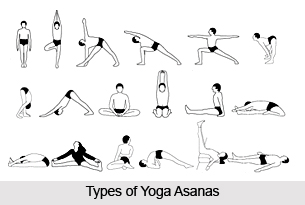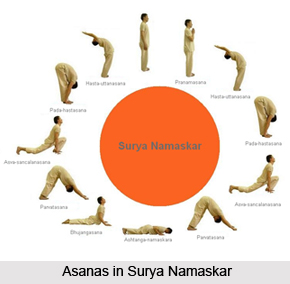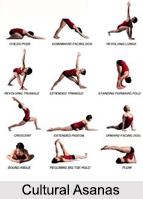 Yoga Asanas have been given several definitions by its practitioners and proponents, but almost all the of them unanimously indicate a pragmatic as well as spiritual aspect to the practice of Yoga Asanas. The term `asana` is defined as sitting on a seat or any particular mode of sitting. The word`s meaning, according to the Kamadhenutantra, is somewhat more complex and mystical, wherein it is derived from three Sanskrit words. Several commentators and theorists of Yoga have defined Asana in a nuanced fashion, and the following details the definition of Asana obtained from the exegeses of various scholars.
Yoga Asanas have been given several definitions by its practitioners and proponents, but almost all the of them unanimously indicate a pragmatic as well as spiritual aspect to the practice of Yoga Asanas. The term `asana` is defined as sitting on a seat or any particular mode of sitting. The word`s meaning, according to the Kamadhenutantra, is somewhat more complex and mystical, wherein it is derived from three Sanskrit words. Several commentators and theorists of Yoga have defined Asana in a nuanced fashion, and the following details the definition of Asana obtained from the exegeses of various scholars.
Meaning of Yoga Asana
The Kamadhenutantra defines Asana as derived in this fashion: A for Atmasamadhi, Sa for Sarvarogapratibandha and Na for Siddhiprapti, indicating that Asana is a means by which enlightenment, freedom from disease, and success is achieved.
Yoga Asana in Yoga Sutras of Patanjali
Patanjali defines asana as a bodily posture that conforms to steadiness (sthairya), and is also pleasant and comfortable (sukham). According to the Patanjali Yoga Sutras, Asanas are practiced effortlessly (prayatnasaithiya), and with an immersion in the infinite (anantasamapatti). When bereft of these two qualities, these postures are no longer yogic and cannot be expected to render the body fit for advanced yogic practices.
Characteristics of Yoga Asanas
 A number of prominent yoga texts have chosen to describe asanas extensively (that is, detailing their properties) rather than intensively (a more rigorous approach, distinguishing what is an asana from what is not). Some extensive definitions of asanas follow.
A number of prominent yoga texts have chosen to describe asanas extensively (that is, detailing their properties) rather than intensively (a more rigorous approach, distinguishing what is an asana from what is not). Some extensive definitions of asanas follow.
Asanas are associated with a lack of movement (niscala) that is not uncomfortable (anudvijaniyam) and is steady, or even attains the stillness of a corpse (mrtavatsthitah). The Yogacintamani insists that an asana can be termed as one only when it does not cause muscular tremors or tensions. The Hindi poet Charandasa defines Asanas as simply the seated postures modeled of different plant and animal species. B.K.S Iyengar, a prominent teacher and theorist of Yoga and Yoga Asanas, distinguishes Asanas from gymnastic exercises, characterizing them as steady postures that enable a mental equilibrium. Iyengar observes that by adopting the pose of any animal or plant, however insignificant, the Yogi is trained not to despise any creature, and apprehend that the Universal Spirit abides in all of creation. He insists that a true asana is one in which the thought of Brahman flows incessantly through the striving (Sadhaka) Yogi`s mind.
Asanas are said to render the body fit in such a manner as to enable the mind to attain spiritual knowledge, thus defining asana as a sacred poise for the body. It is significant in this context that these postures were used in prolonged spiritual rites like Sandhya, meditation, Puja and the fire ceremonies. Hence, Asanas arguably posses a pragmatic definition, that is, a comfortable and steady seated posture, and a more spiritual dimension, as they facilitate spiritual insight even unto an awareness of Brahman. These qualities clearly identify Asanas as one of the most significant and central aspects of Yogic practice.



